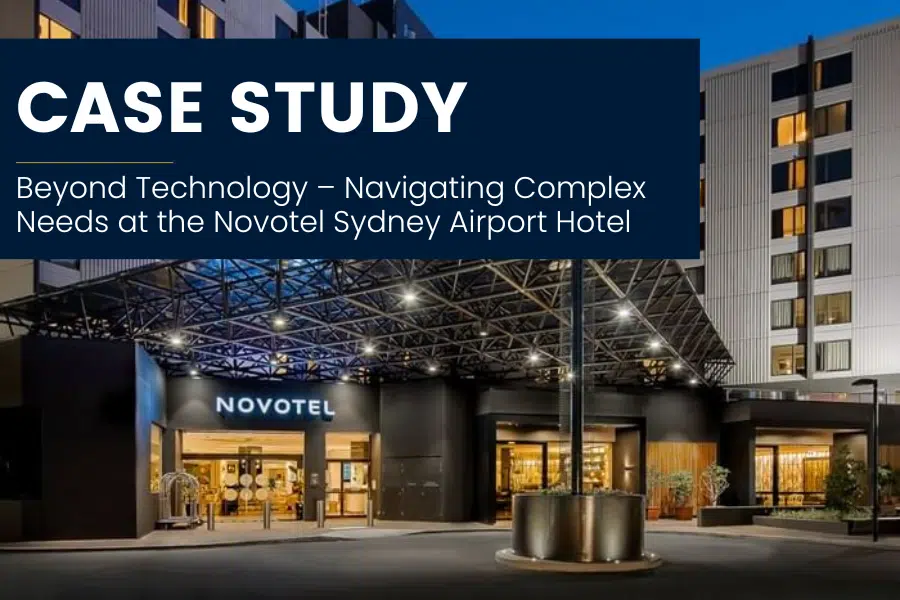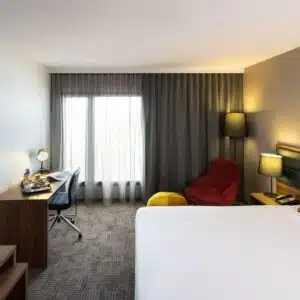Background
The Novotel Sydney Airport Hotel approached Technology4Hotels with a seemingly straightforward request: a quote for two internet-connected televisions to display flight departures using a webpage provided by the Sydney Airport Corporation. As seasoned advisors in the hotel technology industry, we understood that meeting the hotel’s objective required a deeper analysis.
Challenge
Our founder, Brendon Granger, initiated a detailed consultation to uncover the underlying needs and potential challenges in the hotel’s request. This consultation brought to light several critical elements:
- The webpage was a private, subscription-based portal requiring a login.
- The TVs would operate round the clock, year-round, demanding commercial-grade devices.
- Post a power outage or TV reboot, the re-entry of the URL by the Manager on Duty posed a logistical issue.
Solution
Committed to offering more than just hardware, Brendon and his team devised a multi-faceted solution:
- Network Whitelisting: Collaborated with the Sydney Airport Corporation and the Hotel ISP to whitelist the IP addresses of the TVs, eliminating the need for login to WiFi and Sydney Airport Corporation.
- Commercial Grade TVs: Proposed the procurement of commercial grade TVs capable of 24/7 operation, and an automatic connection to the internet, enhancing operational efficiency.
- Auto URL Reload: Identified a commercial-grade TV that allowed URL programming to autoload post any reset, ensuring a hassle-free experience for the hotel staff.
Results
The inquiry transformed into a robust solution that seamlessly integrated technology to offer a streamlined operation. Key achievements included:
24/7 Display: Two commercial-grade TVs operating uninterruptedly, providing updated flight information at all times for guests.
Simplified Management: Through the installation of TVs with auto URL reload features, managers could operate without worrying about manual resets post power outages.
Efficiency: Saved the hotel considerable time and resources by preemptively solving potential challenges and eliminating the need for continuous coordination with different companies.
Conclusion
At Technology4Hotels, we transformed a simple inquiry into an opportunity to enhance the Novotel Sydney Airport Hotel’s operational efficiency and guest experience, aligned with our core values of offering solutions that go beyond expectations, always putting help first without expecting anything in return.
By envisioning the broader picture and meticulously addressing potential challenges, we saved the hotel from a substantial waste of resources and offered a solution that stood tall on functionality and reliability.
This case vividly illustrates how we stand as more than a technology provider; we are trusted advisors steering our clients toward solutions that resonate with efficiency, foresight, and excellence. It’s not just about technology; it’s about leveraging it to the fullest potential, ensuring our solutions not only meet but exceed operational needs and expectations, fostering a relationship grounded on trust, expertise, and a deep-seated desire to see our clients succeed.
Need help considering or selecting the best technology for your Hotel and guests? Technology 4 Hotels can save you time and hassle, and help you increase your revenue. If you have feedback on this article or would like to connect, please get in touch via phone at +61 2 8317 4000, or book a time for a complimentary 15-minute Tech Chat, just click here.
Frequently Asked Questions
A: Consumer-grade TVs and commercial-grade TVs are designed to cater to different environments and have distinguishing features that make them suitable for various applications. Below we outline the main differences between the two:
1. Durability and Lifespan
- Consumer-Grade TVs: Suitable for a few hours of daily use, built with lower tolerance components.
- Commercial-Grade TVs: Designed for 24/7 use, made with more durable components.
2. Warranty and Support
- Consumer-Grade TVs: Limited warranty, potentially voided by commercial use; standard customer support.
- Commercial-Grade TVs: Business-oriented warranties and specialised customer support. Generally on-site support rather than return to base
3. Display and Performance
- Consumer-Grade TVs: Lower brightness and resolution optimised for general viewing experiences.
- Commercial-Grade TVs: Higher brightness to suit well-lit environments and configuration to avoid burn-in issues from static images.
4. Connectivity and Integration
- Consumer-Grade TVs: Basic connectivity and integration features for home use.
- Commercial-Grade TVs: Advanced connectivity options and seamless integration into commercial setups, including centralised control over multiple displays.
5. Functionality and Flexibility
- Consumer-Grade TVs: User-friendly interfaces with limited customisation options.
- Commercial-Grade TVs: Advanced software for greater control and customisation, including branding opportunities.
6. Price
- Consumer-Grade TVs: Generally more affordable but with fewer features.
- Commercial-Grade TVs: Higher cost due to advanced features and durability.
Conclusion
Consumer-grade TVs are suitable for residential settings with lighter usage needs, whereas commercial-grade TVs cater to business environments requiring robust features and continuous operation.
A: “Whitelist” refers to a list of approved entities that are granted access or privileges within a certain system or network. In the context of network security, a whitelist will contain IP addresses, websites, or applications that are allowed to interact with the network or system, bypassing any security measures or restrictions that are in place. By being on a whitelist, these entities are considered safe and trusted, preventing them from being blocked or filtered by security protocols or firewall settings. Whitelisting helps in maintaining security by restricting access only to known, safe entities. In the case above with the Novotel Sydney Airport, it meant that the TVs were trusted on the network and could automatically login onto the WiFi network and the IP address of the hotel was recognised by Sydney Airport Corporation so that the departures could be displayed without the need for someone to log in.



